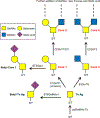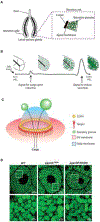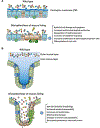In vivo models of mucin biosynthesis and function
- PMID: 35278522
- PMCID: PMC9068269
- DOI: 10.1016/j.addr.2022.114182
In vivo models of mucin biosynthesis and function
Abstract
The secreted mucus layer that lines and protects epithelial cells is conserved across diverse species. While the exact composition of this protective layer varies between organisms, certain elements are conserved, including proteins that are heavily decorated with N-acetylgalactosamine-based sugars linked to serines or threonines (O-linked glycosylation). These heavily O-glycosylated proteins, known as mucins, exist in many forms and are able to form hydrated gel-like structures that coat epithelial surfaces. In vivo studies in diverse organisms have highlighted the importance of both the mucin proteins as well as their constituent O-glycans in the protection and health of internal epithelia. Here, we summarize in vivo approaches that have shed light on the synthesis and function of these essential components of mucus.
Keywords: Colon; Drosophila; Muc2; Muc5ac; Muc5b; Mucins; Mucus; O-glycosylation; Salivary gland; Secretion; Secretory granules; Small intestine.
Published by Elsevier B.V.
Conflict of interest statement
Declaration of Competing Interest The authors declare that they have no known competing financial interests or personal relationships that could have appeared to influence the work reported in this paper.
Figures




References
-
- Desseyn JL, Aubert JP, Porchet N, Laine A, Evolution of the large secreted gel-forming mucins. Mol Biol Evol 17, 1175–1184 (2000). - PubMed
Publication types
MeSH terms
Substances
Grants and funding
LinkOut - more resources
Full Text Sources
Molecular Biology Databases
Miscellaneous

